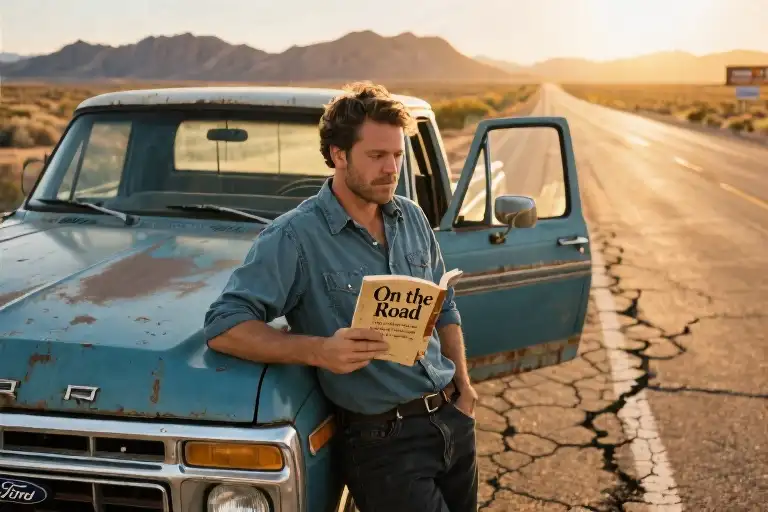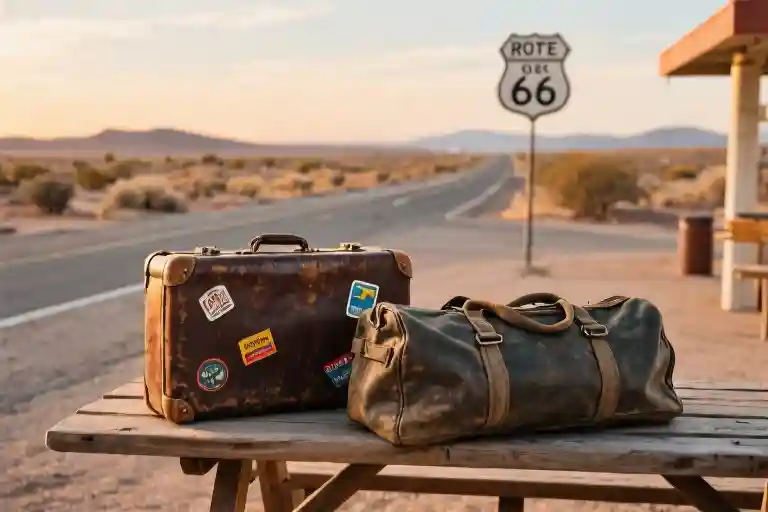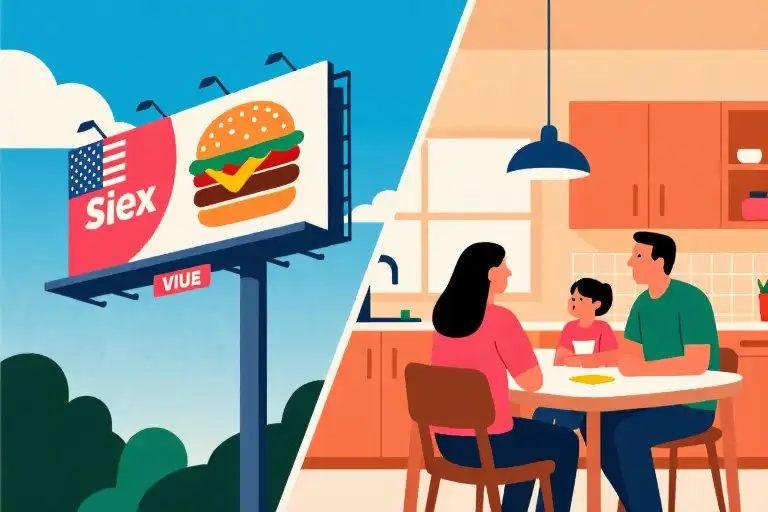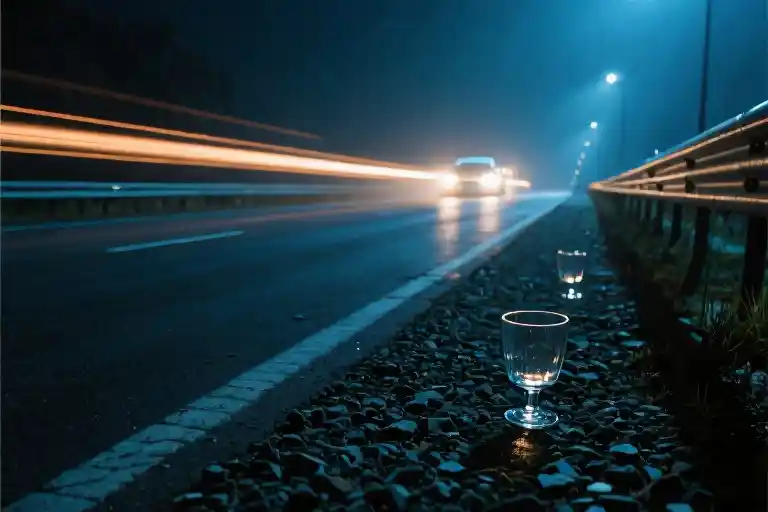The gas pump clicks off with that familiar metallic sound, snapping your attention back from the endless ribbon of asphalt stretching toward the horizon. As you replace the nozzle, a gust of wind carries the scent of sagebrush and diesel – the signature perfume of America’s western highways. Your fingers absently trace the car’s sun-warmed hood while your eyes follow a hawk circling above the rest stop, its shadow darting across the cracked pavement like a fleeting thought.
This is the moment every road traveler knows: when the mechanical rhythm of driving gives way to the landscape’s silent invitation. Jack Kerouac captured it perfectly when he wrote, “Because I had no home, the road became my home.” That visceral understanding of freedom – not as abstract concept but as wind through your hair, as the vibration of tires singing on hot pavement – is woven into America’s cultural DNA.
From the switchbacks of the Sierra Nevadas to the hypnotic straightaways of Barstow’s desert highways, these roads have inspired generations of writers, musicians, and dreamers. They’ve witnessed Woody Guthrie’s protest songs transform into national anthems, seen beat-up station wagons carry Kerouac’s characters toward enlightenment, and now cradle your own journey in their weathered concrete embrace. But what makes this particular brand of freedom – this particular relationship between Americans and their sprawling landscape – so fundamentally different from anywhere else in the world?
The answer lies in the very asphalt beneath your feet. Unlike Europe’s ancient pathways or Asia’s modern expressways, America’s highways tell a story that’s still being written. They cross not just geography but contested ideas about ownership and access. That rest stop you’re standing in? It borders federally protected land that belongs equally to a Manhattan banker and a Nevada ranch hand. The hawk’s hunting grounds? Preserved not by aristocratic decree but by generations of citizen activists who fought corporate interests seeking to fence off the horizon.
As you stretch your legs and watch eighteen-wheelers blur past, consider this: your road trip isn’t just a vacation. It’s participation in America’s longest-running experiment in democracy – one where the currency isn’t votes but miles, where the polling places are scenic overlooks and truck stop diners. The adventure calling from that distant horizon isn’t merely personal; it’s collective. This land was made for you and me, as Guthrie reminded us, but only if we keep remembering – and fighting for – what that really means.
Wheels of Legend: The Highway as Cultural Icon
The Sierra Nevada Switchbacks and Dharma Bums Revelation
Navigating the serpentine roads of the Sierra Nevadas feels like flipping through the dog-eared pages of Kerouac’s The Dharma Bums. Each hairpin turn reveals another layer of the American psyche – the restless pursuit of enlightenment through movement. The mountain air smells of pine resin and gasoline, a peculiar blend that somehow encapsulates the duality of spiritual seeking and mechanical progress.
Local climbers still point out the exact vista where Japhy Ryder (based on real-life poet Gary Snyder) taught Ray Smith about ‘the rucksack revolution.’ Standing at Donner Pass overlook today, you’ll witness the same geological theater that inspired Kerouac’s ecstatic prose about ‘the snowy Sierras bursting upward in the night.’ Modern travelers often leave dog-eared copies of the novel in the rusted mailbox at the trailhead – a spontaneous literary shrine.
Barstow’s Infinite Straightaway: The American Dream’s Double Edge
US Route 66 near Barstow presents the opposite extreme – a hypnotic ribbon of asphalt stretching toward a vanishing point. This is where the romance of the open road collides with its existential reality. The unbroken yellow centerline becomes a metaphor for the American promise: endless possibility stretching before you, yet the pavement still eventually wears thin.
At the Midway Cafe (a 1950s relic miraculously surviving between truck stops), the jukebox plays Guthrie and Springsteen on perpetual rotation. Regulars will tell you about watching hopeful families in overloaded station wagons heading west in the 1960s, then seeing those families’ grandchildren returning east in U-Hauls decades later. The highway forgives no one’s naivete, yet still seduces each new generation.
Trucker Wisdom: “Out Here, Time Wears Like Tires”
Conversations at Barstow’s 24-hour diners reveal the highway’s hidden curriculum. Veteran trucker Marlene Vasquez, logging over 3 million miles since 1989, shares her philosophy between coffee refills: “These roads teach you patience and impermanence. Your rig’s clock might say you’re making good time, but the desert doesn’t care about schedules.”
Her observation echoes the On the Road manuscript’s famous scroll – a continuous 120-foot paragraph celebrating motion over destination. The truckers’ lounge at the Flying J station displays a curious artifact: a bulletin board covered with Polaroids of cracked windshields, each tagged with mileage numbers. Not trophies of misfortune, but reminders that every journey leaves its mark on both traveler and terrain.
Cultural Waypoints Along the Asphalt
- The Beat Museum (San Francisco): Original On the Road draft pages and Neal Cassady’s actual 1949 Hudson
- Amboy Crater (Route 66): Volcanic landscape that inspired desert spirituality in Dharma Bums
- Barstow Station:
- Historic Harvey House where Kerouac slept
- Mural depicting Guthrie’s 1940s Dust Bowl migration
- Sierra Nevada Poetry Trail: Stone tablets engraved with wilderness-themed verses along Highway 395
This stretch of American highway culture remains startlingly intact – if you know where to look. As the afternoon sun slants through the diner’s nicotine-stained windows, the jukebox clicks to another Guthrie track. Outside, a new traveler pauses at the fuel pumps, gazing toward the horizon where the mountains meet the sky. The call remains irresistible.
The Land Wars: From Guthrie to Wall Street
The Protest Lyrics They Didn’t Want You to Hear
Woody Guthrie’s This Land Is Your Land plays at elementary school assemblies across America today, its cheerful melody belying the radical heart of the original 1940 composition. Few know about the missing verses – the ones that never made it into children’s songbooks.
“There was a big high wall there that tried to stop me\ The sign was painted, said ‘Private Property’\ But on the back side, it didn’t say nothing\ This land was made for you and me.”
These lines cut to the core of America’s ongoing struggle over public lands. Guthrie wrote the song as a direct response to Irving Berlin’s God Bless America, which he felt ignored the economic hardships of ordinary people during the Great Depression. That rebellious spirit still echoes along Western highways where “No Trespassing” signs increasingly dot landscapes that generations have considered communal treasures.
The Grand Canyon Cable Car Controversy
In 2023, a $280 million development proposal for the Grand Canyon’s eastern rim sparked nationwide outrage. The project promised a state-of-the-art gondola system that would shuttle 10,000 visitors daily to the canyon floor – right through the heart of sacred Havasupai tribal lands.
Proponents argued it would create jobs and improve access for elderly visitors. Opponents saw something darker: the latest attempt to monetize wilderness that belongs to all Americans. The National Park Service received over 120,000 public comments, with 94% opposing the development. As one Navajo elder testified at hearings: “They want to turn our church into an amusement park.”
By the Numbers: Who Owns America’s Wilderness?
| Land Type | Percentage | Management | Key Threats |
|---|---|---|---|
| National Parks | 3.5% | Federal (NPS) | Overcrowding, deferred maintenance |
| BLM Lands | 10.5% | Federal (Bureau of Land Management) | Mining/drilling leases |
| National Forests | 8.5% | Federal (USFS) | Logging, road construction |
| State Parks | 2.3% | State Governments | Budget cuts |
| Privately Held | 60.2% | Corporations/Individuals | Development, restricted access |
Source: U.S. Geological Survey 2023 Land Ownership Report
These numbers reveal the fragile balance of America’s public lands system. While federal protections exist for iconic places like Yosemite, vast stretches of BLM land remain vulnerable to extractive industries. The 1872 Mining Law still allows corporations to purchase federal mineral rights for just $5 per acre – a policy unchanged since Ulysses S. Grant’s presidency.
The Road Ahead
What Guthrie understood in 1940 remains true today: America’s landscapes tell the story of who we are as a people. Every time we defend a canyon from developers or keep a forest trail open to all, we’re writing new verses to that old protest song. The highway doesn’t care if you’re a billionaire or a broke poet – the horizon belongs to whoever dares to look at it.
Writing Your Road Story: Routes That Matter
The Kerouac Inspiration Trail (San Francisco → Denver)
Following Jack Kerouac’s footsteps isn’t just about mileage—it’s about tracing the contours of American consciousness. This 1,200-mile route along historic US-40 and I-80 mirrors the journey that birthed On the Road, with essential stops that still vibrate with Beat Generation energy:
- City Lights Bookstore (San Francisco): Where Kerouac’s manuscript first found champions. The poetry room upstairs preserves original vinyl recordings of his readings.
- Neal Cassady’s Denver: The real-life Dean Moriarty’s former residence at 1400 Clarkson Street remains a pilgrimage site. Local jazz bars like El Chapultepec still host the improvisational spirit Cassady embodied.
- Great Salt Lake Detour: Kerouac’s description of “the whitest salt desert in the world” holds true. Visit Antelope Island at sunset for the same shimmering vistas that inspired The Dharma Bums.
Pro Tip: Time your trip for October to catch Denver’s annual Kerouac Fest, where contemporary writers retrace this route in a modern-day scroll-writing marathon.
The Protest Song Line (Guthrie to Standing Rock)
Woody Guthrie’s guitar carried more than tunes—it bore witness. This route connects landmarks where music met activism:
- Woody Guthrie Center (Tulsa, OK): Interactive exhibits decode the original, uncensored lyrics of This Land Is Your Land—including the banned verses criticizing private property.
- Dakota Access Pipeline Protest Site (Standing Rock, ND): Walk the prayer camps where 21st-century water protectors channeled Guthrie’s spirit. Local guides share oral histories at the Mni Wiconi memorial.
- Gallup, NM Rail Yards: Where Guthrie penned Deportee (Plane Wreck at Los Gatos) after witnessing migrant worker exploitation. The still-active tracks underscore ongoing labor struggles.
Roadside Wisdom: Pack a harmonica. Many stops along this route host nightly folk circles—just as Guthrie would have wanted.
Road Warrior’s Toolkit: Travel Consciously
For Your GPS:
- Public Lands Project maps free camping spots on BLM land
- Roadtrippers filters stops by cultural/historical significance
Give Back:
- Volunteer with National Parks Conservation Association on trail restoration
- Document ecological changes for Road Ecology Citizen Science
Safety Notes:
- Always carry 2 gallons of water per person in desert stretches
- Download offline maps via Gaia GPS—cell service vanishes where the stories begin
Your tires on asphalt write the next chapter. Will it be a love letter to open spaces, or a call to protect what’s left? The highway awaits your answer.
The Road Ahead: Your Story Awaits
The windshield of your car has framed countless sunsets over desert mesas, reflected storm clouds gathering above mountain passes, and witnessed the quiet magic of small-town diners at dawn. These are more than just miles logged—they’re fragments of an ongoing American story where you’re both the narrator and protagonist.
What Does Your Rearview Mirror Hold?
Every scratch on your bumper, every faded road map in your glove compartment, every truck-stop conversation that lingered longer than expected—they all add layers to your personal odyssey. The beauty of American road trip culture lies in its democracy: whether you’re retracing Kerouiac’s route through the Sierra Nevadas or discovering your own version of Barstow’s endless highways, your journey contributes to this living tapestry.
Consider this:
- The coffee stain on your passenger seat from that Utah diner where the waitress called everyone “honey”
- The detour you took to avoid a wildfire, only to stumble upon a BLM-protected canyon at golden hour
- The protest signs you passed near Dakota Access Pipeline, echoing the spirit of Woody Guthrie’s original lyrics about “private property”
These moments transform from mere memories into cultural artifacts when shared. They become part of America’s ongoing conversation about public lands protection, about what “This Land Is Your Land” truly means when corporate interests still eye our wilderness as untapped revenue.
Passing the Wheel Forward
As your tires kick up dust on some gravel road between monuments and memories, remember you’re not just a traveler—you’re a steward. That national park entry fee? It’s a vote. That Instagram story tagging #KeepPublicLandsPublic? It’s a manifesto. That hour spent picking up trailhead trash? It’s a love letter to future road trippers.
Here’s how to keep the story alive:
- Support the National Parks Foundation (even $5 helps maintain those scenic overlooks)
- Share your favorite underrated public land with #MyAmericanRoadTrip
- Next road trip, swap one chain hotel night for camping on BLM land
The Horizon Never Ends
Your dashboard compass points onward, but before you accelerate into the next adventure, take a breath. Look at the photo on your phone from that Wyoming rest area where the sky outnumbered the cars 1000:1. That’s not just your story—it’s our story. The highway will wait while you add your verse.
“The road is life.” Kerouac wrote that, but you’re living it. So tell us: what version of America have your headlights revealed lately?





